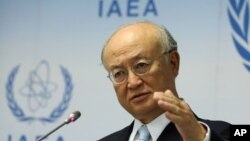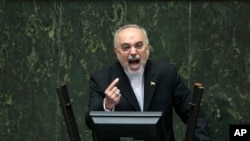Iran has started cutting back on parts of its nuclear development program that could be used to produce nuclear weapons, as required by the landmark agreement Tehran reached with major world powers four months ago, according to a report by the International Atomic Energy Agency.
However, diplomats familiar with the IAEA report cautioned that Iran is keeping on standby thousands of centrifuge machines that could easily be returned to service for use in a prohibited weapons program.
Versions of the confidential report to the U.N. that circulated Wednesday said Iran's main nuclear-enrichment center has 11,308 centrifuges installed, as of this week — more than 3,000 fewer than were in service before October 18, when the nuclear agreement went into effect. The IAEA said some centrifuges also have been removed from a smaller Iranian facility.
Spinning centrifuges
Precision centrifuges, spinning at high speed, are used to separate isotopes of uranium by weight, thus purifying or isolating a concentrated form of the radioactive mineral — "enriched uranium" — that can be used as fuel for nuclear power reactors or other purposes.
An extended enrichment process, which requires many more centrifuges, can produce the highly concentrated form of uranium needed for nuclear warheads.
The agreement that Iran reached in July required Iran to reduce sharply the number of centrifuges it had in service, enough to ensure that Iranian scientists would be unable to produce highly enriched uranium.
Diplomats who spoke to The Associated Press about the report said the thousands of machines that remain on standby can be restarted and brought back online, or into service, on short notice.
Uranium stockpile
The U.N. report also said Iran's stockpile of low-enriched uranium has increased in the past three months, instead of being significantly reduced, as was required, a Reuters report said.
Under the agreement that Iran and the major powers signed on July 14, Iran promised to scale back dramatically its nuclear program and to reduce by two-thirds the number of centrifuges it possessed.
In addition, Iran pledged to change the design of a new reactor at Arak in order to reduce sharply the amount of — a key ingredient for nuclear weapons — the facility would produce.
In return, the six major powers — the United States, Russia, China, Britain, France and Germany — agreed to lift sanctions they have imposed on the Islamic republic.









